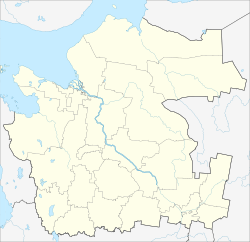
The Tupolev Tu-16 is a twin-engined jet strategic heavy bomber used by the Soviet Union. It has been flown for almost 70 years. While many aircraft in Soviet service were retired after the Cold War ended, the Chinese license-built version Xian H-6 remains in service with the People's Liberation Army Air Force, with more being built as of 2020.

The Tupolev Tu-4 is a piston-engined Soviet strategic bomber that served the Soviet Air Force from the late 1940s to mid-1960s. The aircraft was a copy of the American Boeing B-29 Superfortress, having been reverse-engineered from seized aircraft that had made emergency landings in the USSR.
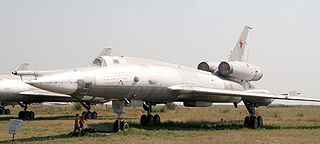
The Tupolev Tu-22 was the first supersonic bomber to enter production in the Soviet Union. Manufactured by Tupolev, the Tu-22 entered service with Long-Range Aviation and Soviet Naval Aviation in the 1960s.

The Tupolev Tu-160 is a supersonic, variable-sweep wing nuclear-capable heavy strategic bomber and airborne missile platform designed by the Tupolev Design Bureau in the Soviet Union in the 1970s. It is the largest and heaviest Mach 2+ supersonic military aircraft ever built and second to the experimental XB-70 Valkyrie in overall length and top speed. As of 2024, it is the largest and heaviest combat aircraft, the fastest bomber in use and the largest and heaviest variable-sweep wing airplane ever flown. The Tu-160 is operated by the Long Range Aviation of the Russian Aerospace Forces.

The Tupolev Tu-95 is a large, four-engine turboprop-powered strategic bomber and missile platform. First flown in 1952, the Tu-95 entered service with the Long-Range Aviation of the Soviet Air Forces in 1956 and was first used in combat in 2015. It is expected to serve the Russian Aerospace Forces until at least 2040.

Soviet Naval Aviation was the naval aviation arm of the Soviet Navy.

The Tupolev Tu-22M is a supersonic, variable-sweep wing, long-range strategic and maritime strike bomber developed by the Tupolev Design Bureau in the 1960s. The bomber was reported as being designated Tu-26 by Western intelligence at one time. During the Cold War, the Tu-22M was operated by the Soviet Air Forces (VVS) in a missile carrier strategic bombing role, and by the Soviet Naval Aviation in a long-range maritime anti-shipping role.

Belaya is a significant Russian Aerospace Forces Long-Range Aviation base in Usolsky District, Irkutsk Oblast, Russia, located 18 kilometres (11 mi) north of Usolye-Sibirskoye and 85 kilometres (53 mi) northwest of Irkutsk. From 2009 it has sometimes been known as Srednii. It has significant ramp space and 38 bomber revetments.

Ukrainka is one of Russia's largest strategic Long Range Aviation bases in the Russian Far East. Located in Amur Oblast, Russia, 28 km north of Belogorsk, and 8 km north of the town of Seryshevo, it is a major nuclear bomber base, with large tarmacs and nearly 40 revetments.

Olenya has been a major Russian Navy reconnaissance base, located on the Kola Peninsula 92 km south of Murmansk. As of 2020, units at the base are subordinate to the Long-Range Aviation branch of the Russian Aerospace Forces. The base and its staff settlement, across Lake Permusozero from the city of Olenegorsk, are served by the Olenegorsk rail station. Olenya has served as the headquarters for 5 MRAD, and has hosted two reconnaissance regiments. Its 3500-meter runway is the longest on the Kola Peninsula, making it a key facility for intercontinental flights across the North Atlantic basin.
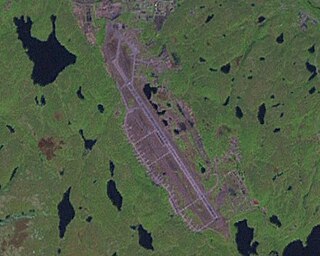
Severomorsk-1, formerly known as Vayenga-1, is a naval air base in Murmansk Oblast, Russia 4 km (2.5 mi) south of Severomorsk. It one of the largest airfields on the Kola Peninsula, second only to Olenya. It can accommodate over 40 bombers and a small number of fighters.

Long-Range Aviation is a sub-branch of the Russian Aerospace Forces responsible for delivering long-range nuclear or conventional strikes by aircraft. The Russian Long Range Aviation and its now-dissolved Ukrainian counterpart were both previously part of the Soviet Air Forces, before it was split into the Air Forces of its many successor states, most notably the Russian Air Force and Ukrainian Air Force. Those branches were tasked with long-range bombardment of strategic targets with nuclear weapons.

Kamenny Ruchey is an air base in Russia located 29 km north of Sovetskaya Gavan. Located just north of Vanino, it is a major military naval airfield that has 63 hardened areas. The airfield is designated by CAICA as Kamenny Ruchey, but Russian topographic maps indicate the nearby settlement northeast of the airfield is Mongokhto, which is also synonymous with the military base. The airfield was a joint Soviet Navy base with the 143 MRAD, flying Tupolev Tu-16, Tupolev Tu-22M, and the 310 OPLAP flying Tupolev Tu-142 aircraft.
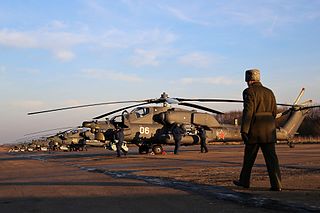
Ostrov is a Russian Aerospace Forces air base in Pskov Oblast, Russia located 7 km southeast of Ostrov and 57 km south of Pskov. It was subordinate to the Baltic Fleet and was a nuclear bomber facility with 15 very large revetments on the east side of the airfield and about 30 small revetments on the west side. As many as 63 Tupolev Tu-16s were based here. A US intelligence analysis in 1984 identified a normal complement of 52 Tu-16 aircraft at Ostrov. The base hosted the Russian Navy's 444th Center for Combat Employment and Retraining of Personnel Naval Aviation.
Kaliningrad Chkalovsk is a naval air base in Chkalovsk, Kaliningrad Oblast, Russia located 9 kilometers northwest of Kaliningrad. Most instances in Russian aviation literature of Chkalovsk or Chkalovskoye refer specifically to this large airfield. A significant Baltic naval base, it is Kaliningrad's largest airfield with four separate complexes for bomber and fighter parking.

Shaykovka, also given variously as Kirov Shaykovka, Anisovo Gorod, Anisovo Gorodishche, Shaykovo, Shajkovka, Gorodische, Chaikovka, is an airbase of the Russian Aerospace Forces in Kaluga Oblast, Russia located 17 km north of Kirov, Kaluga Oblast. It is a large airfield with hangars and an extensive alert area for fighters. Appears the runway overrun was being built to extend the runway to 3000 m. In 2000, Tupolev Tu-160, Tupolev Tu-95MS, and Tupolev Tu-22M3 aircraft operated out of this base during a training exercise. The Natural Resources Defense Council listed the base as a nuclear site in a study.
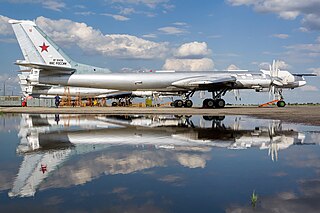
Engels-2 is a strategic bomber military airbase in Russia located 14 kilometres (8.7 mi) east of Saratov. Engels is a major bomber operations base, and is Russia's sole operating location for the Tupolev Tu-160 strategic bomber. The base has a 3,500-metre (11,500 ft) runway and about 10 large revetments. It is named after the nearby city of Engels, which is named after the Communist philosopher, Friedrich Engels.

The Tupolev Tu-142 is a Soviet/Russian maritime reconnaissance and anti-submarine warfare (ASW) aircraft derived from the Tu-95 turboprop strategic bomber. A specialised communications variant designated Tu-142MR was tasked with long-range communications duties with Soviet ballistic missile submarines. The Tu-142 was designed by the Tupolev design bureau, and manufactured by the Kuibyshev Aviation and Taganrog Machinery Plants from 1968 to 1994. Formerly operated by the Soviet Navy and Ukrainian Air Force, the Tu-142 currently serves with the Russian Navy.

The Long Range Aviation Group ; abbr. AGDA / АГДА), was a military organisation, subordinate to the Central High Command of the Ukrainian Air Force, which included the long-range aircraft of Ukraine. Ukrainian Long Range Aviation was disbanded in 2007.
Viktor Pavlovich Potapov was an officer of the Soviet military who held a number of posts in naval aviation, serving as the last head of Soviet Naval Aviation, and the first head of Russian Naval Aviation, reaching the rank of Colonel General.


